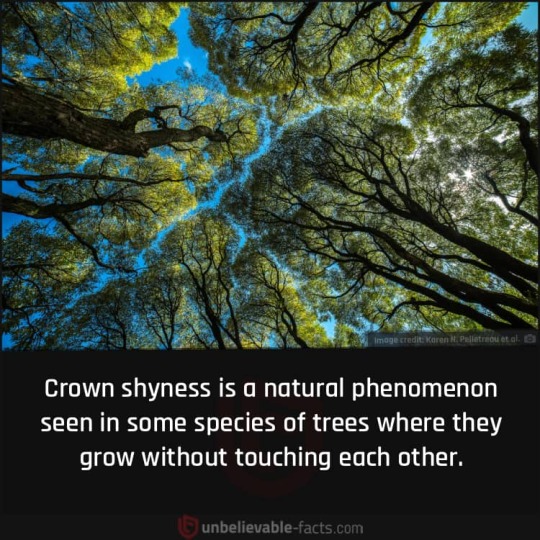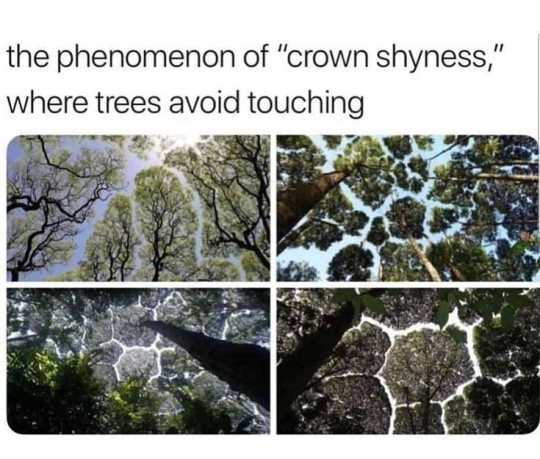#crown shyness
Photo

Crown shyness (also canopy disengagement, canopy shyness, or intercrown spacing) is a phenomenon observed in some tree species, in which the crowns of fully stocked trees do not touch each other, forming a canopy with channel-like gaps. The phenomenon is most prevalent among trees of the same species, but also occurs between trees of different species.
Trees at Plaza San Martín (Buenos Aires), Argentina
2K notes
·
View notes
Text
6/25- crown shyness
sometimes when i look up at the trees
i see the cracks they form in the sky
just enough to let the light come pouring through.
the leaves allow sacred space for each other
the branches reach like outstretched hands and yet never touch.
they say that distance makes the heart grow fonder
though i see it more as an enemies to lovers story
the leaves find solace in the space
and yet the roots below are forever intertwined, holding hands in the midst of obscurity
a world of devotion happening beneath our feet.
the idealism of it all resonates within my tiny mind
and i project these sentiments into my tiny little life.
the favor of wholeness over perfection
that harmony is born from letting the light in.
the beauty of reading between the lines
rejoicing in the gaps in between
and to live with the triggers of peacefulness.
growing means to leave things behind
and i’m learning how to be okay with the empty spaces.
#original poems#daily poems#poetry#poets on tumblr#poets corner#poems#poet#nature#trees#crown shyness
29 notes
·
View notes
Text


Crown shyness phenomenon in the Forest Research Intitute Malaysia (FRIM)!
These borneo camphor/kapur trees (Dryobalanops aromatica) do not let the leaves of their crowns touch each other, showing a beautiful pattern in the sky.
It has been hypothesized that this phenomenon has evolved to prevent the spread of parasites and disease. Or it may be a simple product of strong winds clashing branches together to cause these gaps. Some may also say the lack of sunlight from overlapping foliage can prevent leaves from growing too close to each other.
Regardless, it is a beautiful sight. Sunlight shyly weaves through the gaps to land on our faces. It was a brief respite before we continued on our hike through the forest in 2023.
4 notes
·
View notes
Text
Plant vision.
Im supposed to be reading TRAQ and MUNICIPAL ARBORIST SPECIALIST. for ISA CERTs rn. But Instead I listened to Beechhouse 7 and depression cherry and rabit holed plant physiology. Here me out though, it was a good rabit hole. A real shower thought provoker if you know what I am sayin’
We can talk about Population dynamics in so many ways; motile plants are interesting, and clustering for light competition is interesting too, as well as clustering for annual roots.
Under immense evolutionary pressure certain physiological traits can stack and form critical key elements for certain species survival function.
Today I binged some old physiology literature to introduce far red light, red light, and blue light sensing forces as a dynamically important factor in plants ability to figure out shapes and move accordingly, this is advanced phototropism. We can look at population stand interactions where not just trees of the same species, but trees of variable age, variable size, variable clustering, variable spacing, compete for light over time and eventually close a canopy and can form cracked spacing and even fill in beneficial micro edges with perfect shape adjustments.
This forms the dome and crack puzzle effect we rarely see as Crown Shyness
With this said, I learned some really cool stuff due to the foot notes as I googled the term Plant-Specific Ocelli after reading the glossary definition; and we need to talk really quickly because their are non predatory(parasitic seeker plants) that can sense other life around them, not by chemotropism, not by twining till you touch something, not by organic depletion or bacterial/ fungal trails, but by vision, and Im not just talking about far red light sensing and moving a leaf a little bit to fill in a puzzle, im talking, biomimicry of shapes and with no chemical needed.
https://www.sciencedirect.com/science/article/abs/pii/S1360138516300930
https://pubmed.ncbi.nlm.nih.gov/27491517/

Boquila trifoliolata, once thought to be parasitic relative or protoparasitic and evolving under predator prey selective pressure to have a functional ability to match it’s leaves to any plant it grows adjacent too, matches it’s “host” plant as biomimicry to fit in and or fool predators through transposable copying or splicing as a parasitic gene transfer, similar to doddar’s ability to do gene transfer for allelopathic prevention and to trick the host into thinking it’s not being parasitized.
Well...
This idea of how it changes shape turned out to be wrong, infact you can lay it across a bench of random species and over time depending on how dense the different species are and how spread out they are, it will adapt to multiple leaf shapes on the same plant at once. Truly plastic(meaning capable of change) and polymorphic in this respect.
Not only does it do that without parasitism there was a test on fake plants done to see if it would have a change/ association, not only did it not form any haustoria with the fake plant, it changed it’s leaves so its plasticly polymorphic and capable of sensing shapes to change into them which means it has a form of vision that isn’t a normal light based motor movement form of Plant specific ocelli. From what i’ve red, it’s plastic clustering and it’s reticulate venation under certain shade are meristemally motile, react to light, adjust photo-receptors through movement, and grow and abort to form the leaves new shape which is adjusted in short node -internode- node sections.
So now, I also know that arabidopsis, which is a model annual plant species, has root sense plant specific ocelli, and a number of algae have them too. What I want to know now is are there forms of this in populations of walking fern, if algae have done this what about pnuematophore balast species of plants that have to have their traps at an ideal depth for light and feeding on microorganisms like
Utricularia spp. which use upper branches as surface area stabilizers more than for food collection.
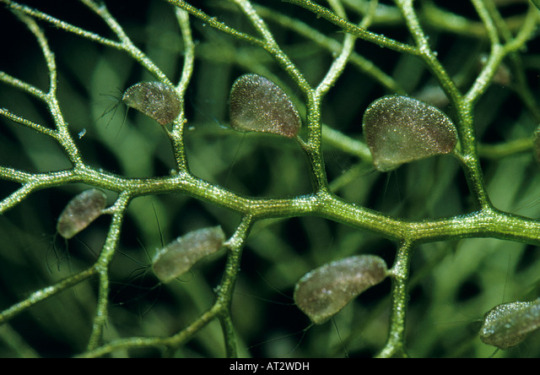
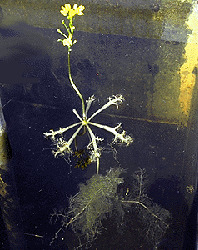
And if so what species, would have said visual depth gauge
#plantspecificocelli#plant specific ocelli#ecology#plantblr#plant physiology#crown shyness#crownshyness#botany
26 notes
·
View notes
Text


Treehouse Gardens
26 notes
·
View notes
Quote
"Well, that's the nice thing about trees." Mosscap put its hands on its hips and looked around. "They're not going anywhere. You can take all the time you need to know them."
A Prayer for the Crown-Shy, by Becky Chambers
#page 110#a prayer for the crown-shy#a prayer for the crown shy#monk and robot#becky chambers#scifi#cozy#cozy scifi#sibling dex#dex#splendid speckled mosscap#mosscap#crown shyness#tree#plant#botony#time#understanding#quote#quotes#literature#book#booklr#reading
20 notes
·
View notes
Photo

Trash Boat - Inside Out
23 notes
·
View notes
Text

If you're a fan of the Becky Chambers Monk & Robot series like I am, you might have heard the term "crown-shy" before. Crown shyness or Canopy shyness is a phenomenon where trees in a forest canopy grow really close together so they are almost, but not quite touching, leaving little gaps between. I just think this phenomenon is really neat, and it inspired me to create this watercolour painting.
#becky chambers#monk and robot#crown shyness#canopy#forest#trees#watercolour#green art#australianartist#klbaileyart
2 notes
·
View notes
Photo

The Grey Dance by Väinö Kunnas // Crown Shyness by Anna B Savage
#anna b savage#crown shyness#in|flux#lyrics#lyric edit#lyric art#art history#web weavin#new music#indie music#art pop#chamber pop#my pos
3 notes
·
View notes
Text


oh arresting and rewiring.......
#havent listened to any of her individual (of a sort) work yet actually but this take on forgiveness is shaking me down like a fruit tree#crown shyness
4 notes
·
View notes
Text
autistic trees my beloved <3
3 notes
·
View notes
Text









The Alphabet With Tomsmusictaste | T
#the alphabet with tomsmusictaste#taking back sunday#louder now#tell all your friends#makedamnsure#twenty#thirty seconds to mars#this crooked home#distance#time tells all#spread the word#trash boat#nothing i write you can change what you've been through#crown shyness#trucks#trucks band#juice#twenty twenty#small talk
3 notes
·
View notes
Text
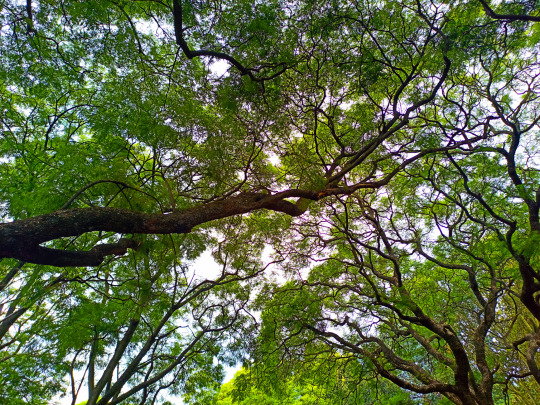
Trees in Johannesburg, South Africa
1 note
·
View note
Text
Melhores Músicas Internacionais de 2023
Chegou as nossas escolhas de melhores músicas de 2023. Com diversas e muito boas canções internacionais, foi fácil compilar a lista sendo que muitos bons candidatos ficaram de fora. Com nomes que soltaram um single neste ano, para novos nomes e grupos, alem de grandes revelações, segue nossas escolhas para as musicas que mais marcaram 2023 para nós.
15 ” Not Strong Enough”- boygenius
Facilmente…

View On WordPress
#2023#a running start#a&w#andy shauf#angelo de augustine#anna b savage#arms#bad idea right#boygenius#countdown to shutdown#crown shyness#deveria ser mainstream#don&039;t get me wrong#dutch uncles#florence +the machine#flyte#halloween store#hot summer#indie#jenny lewis#lana del rey#matchbox twenty#mermaids#not storng enough#olivia rodrigo#oracle sisters#psychoes#san fermin#speech bubble#sufjan stevens
0 notes
